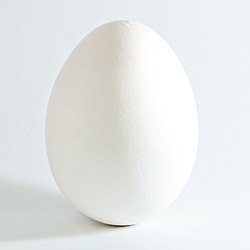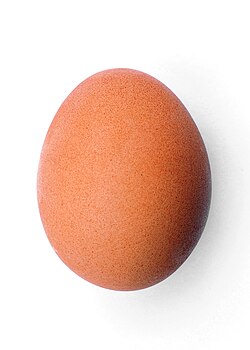Eggshell: Difference between revisions
Super48paul (talk | contribs) Reverted 1 edit by 59.177.35.187 (talk): And = needed! (TW) |
No edit summary |
||
| Line 4: | Line 4: | ||
[[Image:Chicken egg 2009-06-04.jpg|thumb|250px|The shell of a brown [[chicken]] egg]] |
[[Image:Chicken egg 2009-06-04.jpg|thumb|250px|The shell of a brown [[chicken]] egg]] |
||
An '''eggshell''' is the outer covering of a hard-shelled [[egg (biology)|egg]] and of some forms of eggs with soft outer coats. Bird eggshells contain calcium carbonate and dissolve in various acids, including the vinegar used in cooking. While dissolving, the calcium carbonate in an egg shell reacts with the acid to form carbon dioxide. <ref>{{cite web|url=http://van.physics.illinois.edu/qa/listing.php?id=461 |title=Q & A: Eggshells in Vinegar - What happened? | Department of Physics | University of Illinois at Urbana-Champaign |publisher=Van.physics.illinois. |
An '''eggshell''' is the outer covering of a hard-shelled [[egg (biology)|egg]] and of some forms of eggs with soft outer coats. Bird eggshells contain calcium carbonate and dissolve in various acids, including the vinegar used in cooking. While dissolving, the calcium carbonate in an egg shell reacts with the acid to form carbon dioxide. <ref>{{cite web|url=http://van.physics.illinois.edu/qa/listing.php?id=461 |title=Q & A: Eggshells in Vinegar - What happened? | Department of Physics | University of Illinois at Urbana-Champaign |publisher=Van.physics.illinois.eage:Eggs green brown on end.jpg|thumb|200px|Some other colors of chicken eggs]] |
||
== Diversity == |
|||
[[Image:Eggs green brown on end.jpg|thumb|200px|Some other colors of chicken eggs]] |
|||
=== Insect eggs === |
=== Insect eggs === |
||
Revision as of 06:50, 28 September 2013
This article needs additional citations for verification. (February 2008) |


An eggshell is the outer covering of a hard-shelled egg and of some forms of eggs with soft outer coats. Bird eggshells contain calcium carbonate and dissolve in various acids, including the vinegar used in cooking. While dissolving, the calcium carbonate in an egg shell reacts with the acid to form carbon dioxide. Cite error: A <ref> tag is missing the closing </ref> (see the help page).[1][2] Without the protein, the crystal structure would be too brittle to keep its form and the organic matrix is thought to have a role in deposition of calcium during the mineralization process.[3][4][5] The structure and composition of the avian eggshell serves to protect the egg against damage and microbial contamination, prevention of desiccation, regulation of gas and water exchange for the growing embryo, and provides calcium for embryogenesis. Eggshell formation requires gram amounts of calcium being deposited within hours, which must be supplied via the hen’s diet.[2]
The fibrous chicken shell membranes are added in the proximal(white) isthmus of the oviduct.[2] In the distal (red) isthmus mammillae or mammillary knobs are deposited on the surface of the outer membrane in a regular array pattern.[6][7] The mammillae are proteoglycan-rich and are thought to control calcification. In the shell gland (similar to a mammalian uterus), mineralization starts at the mammillae. The shell gland fluid contains very high levels of calcium and hydrogen carbonate. The thick calcified layer of the eggshell forms in columns from the mammillae structures, and is known as the palisade layer. Between these palisade columns are narrow pores that traverse the eggshell and allow gaseous exchange. The cuticle forms the final, outer layer of the eggshell.[8]
While the bulk of eggshell is manate, it is now thought that the protein matrix has an important role to play in eggshell strength.[9] These proteins affect crystallization, which in turn affects the eggshell structure. Moreover, the concentration of eggshell proteins decreases over the life of the laying hen, as does eggshell strength.
In an average laying hen, the process of shell formation takes around 20 hours. Pigmentation is added to the shell by papillae lining the oviduct, coloring it any of a variety of colors and patterns depending on species. Since eggs are usually laid blunt end first, that end is subjected to most pressure during its passage and consequently shows the most color.
Environmental issues
The US food industry generates 150,000 tones of shell waste a year.[10] The disposal methods for waste eggshells are 26.6% as fertilizer, 21.1% as animal feed ingredients, 26.3% discarded in municipal dumps, and 15.8% used in other ways.[11] Many landfills are unwilling to take the waste because the shells and the attached membrane attract vermin. Together the calcium carbonate eggshell and protein rich membrane are useless.[12] Recent inventions have allowed for the egg cracking industry to separate the eggshell from the eggshell membrane. The eggshell is mostly made up of calcium carbonate and the membrane is valuable protein. When separated both products have an array of uses.
Mammal eggs
Monotremes, egg-laying mammals, lay soft-shelled eggs similar to those of reptiles. The shell is deposited on the egg in layers within the uterus. The egg can take up fluids and grow in size during this process, and the final, most rigid layer is not added until the egg is full-size.
Egg teeth
Hatching birds, amphibian and egg-laying reptiles have an egg-tooth used to start an exit hole in the hard eggshell.[13][14]
See also
- Eggshell skull rule, in tort law
- Walk on eggshells, an idiom in the English language
References
- ^ Nys, Yves; Gautron, Joël; Garcia-Ruiz, Juan M.; Hincke, Maxwell T. (2004). "Avian eggshell mineralization: biochemical and functional characterization of matrix proteins". Comptes Rendus Palevol. 3: 549–62. doi:10.1016/j.crpv.2004.08.002.
- ^ a b c Hunton, P (2005). "Research on eggshell structure and quality: an historical overview". Revista Brasileira de Ciência Avícola. 7: 67–71. doi:10.1590/S1516-635X2005000200001.
- ^ Romanoff, A.L., A.J. Romanoff (1949) The avian egg. New York, Wiley.
- ^ Burley, R.W., D.V. Vadehra (1989) The Avian Egg: Chemistry and Biology. New York, Wiley.
- ^ Lavelin, I; Meiri, N; Pines, M (2000). "New insight in eggshell formation". Poultry science. 79 (7): 1014–7. PMID 10901204.
- ^ Wyburn, GM; Johnston, HS; Draper, MH; Davidson, MF (1973). "The ultrastructure of the shell forming region of the oviduct and the development of the shell of Gallus domesticus". Quarterly journal of experimental physiology and cognate medical sciences. 58 (2): 143–51. PMID 4487964.
- ^ Fernandez, MS; Araya, M; Arias, JL (1997). "Eggshells are shaped by a precise spatio-temporal arrangement of sequentially deposited macromolecules". Matrix biology. 16 (1): 13–20. PMID 9181550.
- ^ "The Egg-Shell Microstructure Studied by Powder Diffraction". Xray.cz. Retrieved 2012-10-16.
- ^ [1][dead link]
- ^ Hecht J: Eggshells break into collagen market. New Scientist 1999, 161:6-6.
- ^ Daengprok W, Garnjanagoonchorn W, Mine Y: Fermented pork sausage fortified with commercial or hen eggshell calcium lactate. Meat Science 2002, 62:199-204.
- ^ Wei Z, Li B, Xu C: Application of waste eggshell as low-cost solid catalyst for biodiesel production [electronic resource]. Bioresource technology 2009, 100:2883-2885.
- ^ "What is Egg Shell Quality and How to Preserve It". Ag.ansc.purdue.edu. Retrieved 2012-10-16.
- ^ "doi:10.1016/j.crpv.2004.08.002" (PDF). Retrieved 2012-10-16.
Further reading
- Kilner, R. M. (2006). "The evolution of egg colour and patterning in birds". Biological Reviews. 81 (3): 383–406. doi:10.1017/S1464793106007044. PMID 16740199.
